Teaching Wrist Snap
We got an excellent question from reader Shelley this week:
My question is in regards to the teaching the beginner who has never pitched. Do you teach palm control to the target snap first? Do you teach them to snap the ball between their feet? Say 6:00 on a clock? Is there anything else we can do to help beginners feel the snap before we tackle the arm whip?
With the forearm fire technique Is the snap of the pitch out in front of you like when you throw overhand, body behind the ball?
Even my college pitchers need to work on their snaps! Do you have any suggestions?
Shelley very astutely raises an important point. While we do not teach an isolated wrist snap at a specific point in the pitch delivery, wrist snap does occur over the course of forearm fire. It should occur naturally, but when you’re teaching total beginners—especially those in the 9-10 age range, or with a smaller hands—expecting it to occur naturally is very wishful thinking. Often these beginners need to feel what a wrist snap is first, or they won’t be able to do forearm fire correctly.
When I’m working with new beginners individually, this is how I proceed:
Try Forearm Fire First
Whenever possible, I think it’s best to start emphasizing forearm fire right from the beginning. Some rare students will get it naturally, and in those cases there is no sense stiffening them up with isolated snaps.
I used to start with wrist snaps 100% of the time, but recently when I’m starting a beginner one on one I try jumping into forearm fire (without telling them that’s what I’m doing). I tell them to start by playing catch overhand, and then tell them to switch to playing catch underhand, without thinking. This gives me a sense of whether or not they “get it” naturally, or could get it with minimal adjustment.
If they DON’T get it, or if you’re teaching in a group setting where it is not feasible to do this test to each student individually, you can try wrist snap drills.
Isolated Snap Drills
It’s very important to understand before beginning this process that isolated wrist snaps are unnatural. The wrist snap takes place as a part of the overall forearm fire motion, but there is no point at which you stop and snap your wrist during a pitch. If you think of an actual whip, the wrist is like the tip of the whip. If you were cracking a whip, it would be impossible to make just the tip snap; you’d have to whip the whole thing.
However, wrist snap drills used the right way can benefit certain pitchers in getting to their end goal of forearm fire. Here is my must-use guide to implementing wrist snap drills as beneficially as possible:
- Wrist snap drills are a LIMITED TIME thing and should be stopped before the isolation aspect of it gets ingrained into the student’s muscle memory. It’s important for the pitcher to get familiar with the feel of the ball exiting her hand, but once she is producing spin consistently, there is no need to continue wrist snap drills. They will NOT help forearm fire get better, even if the student is able to produce spin with a snap drill and little spin with a forearm fire drill.
- Time frame: It varies from student to student, but when I’m working with a student 1 on 1, maybe I’ll do wrist snaps for the first 3-4 lessons, then I drop it for good (except in extreme cases). We also do 10-week clinics. I’d say typically wrist snap drills would appear in half to all classes of a 10-week beginner session, and then they are never revisited from level 2 on.
- As quickly as possible, move on from the TRULY isolated snaps (holding the arm down, etc.) to something that includes at least a little bit of relaxed arm movement. As important as it is for a student to get the feel of a snap, it’s equally important for her to understand as early as possible that the snap takes place as part of a larger movement.
Drills you can do:
I’d stick to one simple standing isolated snap drill like this:
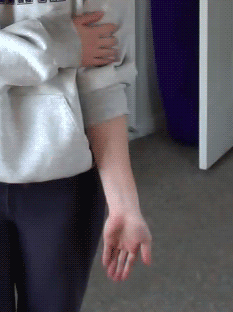
The opposite hand isn’t really holding the arm down; it’s just a useful reminder to the student not to use the rest of her arm at this stage. We’re looking for spin coming from the LOOSE movement of the wrist, and the ball rolling off the fingers.
This is wrong:
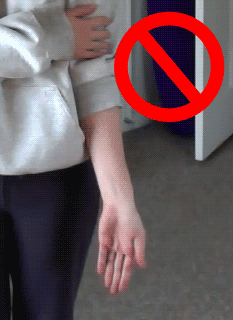
Generating spin with just the fingers is not as powerful. This is also wrong:
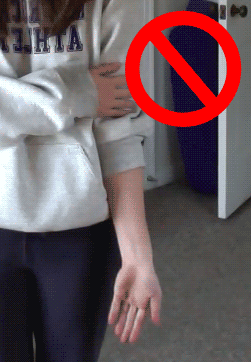
Moving the forearm and NOT the wrist will be very tempting for beginner students, because from a close distance this produces the most power. However, this results in an arm that moves without any actual whip—the biggest problem in people who don’t get forearm fire.
Spend as little time on this as possible. Next, add a small relaxed arm swing, and a finish pointing at the catcher:
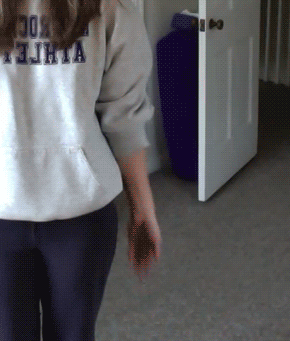
We tell our students to “shake hands” with the catcher. If the wrist is truly relaxed, it should flop over inward. If this isn’t happening, the student isn’t relaxed enough. The motion is continuous; you do not swing back, stop, snap, and then continue. This is the most important thing to teach at this stage.
From there, the transition to basic forearm fire is just in the angle of the body to the catcher and the starting position of the hand:
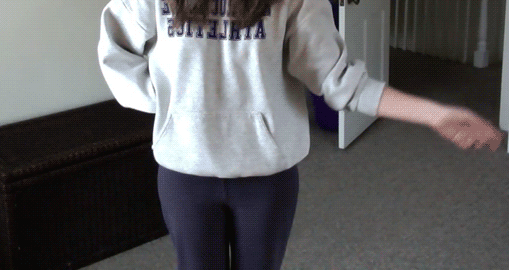
The student “shakes hands twice,” once with someone behind her, once with the catcher. The elbow leading the motion is key.
Where the snap takes place
If you slow down a pitch frame by frame, the ball would leave the hand somewhere in the neighborhood of the front hip. But DO NOT teach a spot for the release; teach a zone. The snap is long and loose and takes place across the entire throw zone. The body is behind the ball at the moment of release.
Helping pitchers who just don’t get it
One of the biggest obstacles in learning to whip is ball size versus hand size. This can affect pitchers all the way up to college. Even if their hands are plenty big for the ball, they could have muscle memory from when their hands were smaller. Doing drills with a smaller ball is one of my favorite ways to help generate more whip and get more spin. Give 14+ pitcher an 11-inch ball; give a younger pitcher a 10-inch. They should always throw their correct ball from full distance, but smaller balls are great for whip and spin drills.
My second piece of advice is regardless of age, no matter how frustrated the pitcher gets, do not move on from isolated forearm fire until she gets it most of the time. Adding other moving parts before the whip is solid will only take her focus away from her arm and make the whip more difficult. This means spending a lot of time on whip drills for younger pitchers, and maybe taking a step back and revisiting basics for older pitchers.
Alternating throwing overhand and underhand can also be helpful. Make sure to concentrate on the arm’s natural snap in the overhand throw and then try to mimic the feeling with the pitch.
Do you see kids getting any soreness in their forearm….if so what do you attribute it to?
Thanks,
Joy Gross
Hi Joy, please see this post for my answer: https://www.fastpitchpower.com/can-cause-forearm-soreness/
Carly,
I have been coaching girl’s fastpitch softball for many years and I am one of those coaches from the old school of getting their pitchers to have a quick arm circle, lead with the thumb at release and just basically snap the wrist and follow through. Their follow through would end, coming up, rather than out toward the catcher.
I have just started watching some of your videos with Phil, but he never really talks about what the wrist and hand are doing at release. Does the wrist automatically turn just before release, which would have the thumb leading, or is the back of the hand not behind the ball at release? I’m just wondering if this is maybe too advanced for 9 and 10 year old girls.
Thank You,
Eddie Tucker .